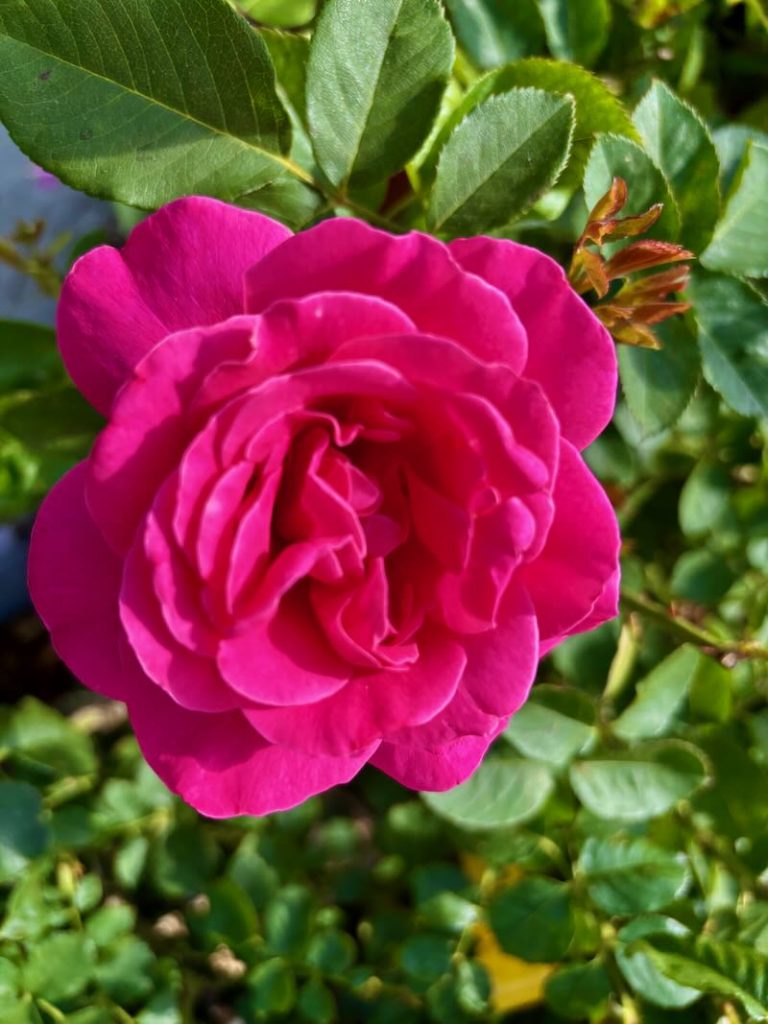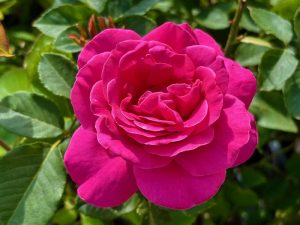Rosa ‘Pink Peace’: Satin-Pink Perfume On Classic Long Stems
Rosa ‘Pink Peace’ or Pink Peace Rose brings the romance of a classic Hybrid Tea Rose together with modern garden performance. The blooms open large and high-centered, then hold their form on strong, straight stems that beg for a vase. Each flower glows bright, deep pink—often with a soft silver cast—and releases a rich, sweet fragrance that recalls old roses. Because buds arise in waves from late spring into fall, you enjoy color and scent for months, not weeks. Plant it where you pass often and you’ll never miss a flush.
Rosa ‘Pink Peace’ belongs to the Rosaceae family. That places it with apples, pears, hawthorns, not to mention other roses. Francis Meilland introduced this cultivar in 1958. He bred it from the legendary ‘Peace’, and the lineage shows. You get the same elegant form and generous bloom, now in vivid pink. Gardeners grow Pink Peace Rose for cut flowers, borders, and as a standout specimen in view of a patio or path.
Why Gardeners Choose Rosa ‘Pink Peace’
You plant Rosa ‘Pink Peace’ because it delivers. The flowers are big—about 12–18 cm (5–7 in) across—double, and packed with petals. Each blossom sits on a long, sturdy stem, which makes cutting easy. The color reads deep, saturated pink in most light; in cool mornings you may notice a silvery edge. The scent is strong and classic. Snip three stems and a room fills with perfume.
The shrub grows upright and bushy. Expect 90–150 cm (3–5 ft) in height and 60–120 cm (2–4 ft) in spread, with the possibility of 180 cm (6 ft) in rich soil and long seasons. Leathery leaves emerge with a reddish tint in spring, then mature to glossy dark green. That foliage frames each bloom and gives the plant presence between flushes.
Blooming Season And Growth Habit
Rosa ‘Pink Peace’ flowers in cycles from late spring to mid-fall. Buds form on new growth, open in a strong wave, then pause while the plant resets. Deadhead promptly and feed after each flush; you’ll see new buds in two to four weeks, faster in warm weather. The shrub keeps an upright, slightly spreading habit. It fills from the base, so you can grow it without fronting perennials to hide bare legs.
Where Rosa ‘Pink Peace’ Looks Best
Show it off. Plant a single Pink Peace Rose as a focal point near a gate or mailbox. Group three in a triangle to anchor a mixed border. Build a fragrance garden with Lavender, Catmint, and Dianthus as companions; they share the same love of sun and airflow. For a lush, formal look, set a pair on either side of steps in tall containers. The long stems and tidy habit keep things elegant. If you want a cut-flower patch, line up plants 75–90 cm (30–36 in) apart in rows so you can step between them to harvest.
Climate, Hardiness, And Tolerance
Hardiness runs USDA Zones 6–10. In cool-summer regions, site the plant in full sun and reflective warmth to push strong flushes. In hot, humid areas, keep the sun but emphasize airflow and morning irrigation to dry leaves early. Rosa ‘Pink Peace’ handles urban conditions and light air pollution. It does not like standing water or heavy shade. Give it draining soil, six or more hours of direct sun, and room to breathe.
A Short Backstory For Rose Fans
Francis Meilland named ‘Pink Peace’ to honor both the beloved ‘Peace’ rose and the hope that beauty cultivates. This Hybrid Tea carries the same high-centered bud form that set the standard for exhibition roses. It also carries a stronger pink color and a fragrance many gardeners prefer for cutting. Award juries agreed; the rose earned major medals in European trials soon after release.
How To Grow Rosa ‘Pink Peace’
You can set this rose up for success with simple, consistent care. Use the steps below to plant it right, water it well, and keep the blooms coming.
Planting And Spacing
Plant bare-root in early spring as soon as you can work the soil. Plant container roses in spring or fall. Dig a hole 45–50 cm (18–20 in) wide and 30–35 cm (12–14 in) deep. Mix the backfill with 20–30% compost. In cold-winter zones, set the graft (bud union) 2–5 cm (1–2 in) below the final soil line. In warm zones, keep it at or just above grade. Spread the roots over a small soil cone, set the plant so the crown sits at grade, and backfill. Water to settle and top with mulch.
Space Rosa ‘Pink Peace’ 75–90 cm (30–36 in) from its neighbors. That gap ensures airflow and easy access for pruning and harvesting.
Light
Give full sun—at least 6–8 hours daily. Morning sun is non-negotiable because it dries dew. In very hot regions, light afternoon shade protects blooms in heat spikes above 35 °C (95 °F). Do not site in the shadow of trees or tall shrubs; competition and shade reduce flowers and invite disease.
Soil
Choose a deep, well-drained, fertile soil. A loam with a slightly acidic to neutral pH (6.0–7.0) performs best. On clay, build a wide, shallow raised bed and add coarse organic matter to open texture. On sand, work in compost to hold water and nutrients. Avoid planting where old roses failed unless you replace a generous volume of soil; you reduce the risk of soil-borne fatigue.
Watering
Water roses deeply. Soak the root zone to 20–30 cm (8–12 in) each time. In new plantings, water two to three times per week in warm weather until you see vigorous new shoots. After establishment, plan on about 2.5–5 cm (1–2 in) of water per week from rain and irrigation, more in heat. Always water at the base. Keep foliage dry to limit black spot and mildew. Morning irrigation is best; it wets the soil and leaves time for stray splashes to dry.
Mulching
Mulch the root zone with 5–8 cm (2–3 in) of shredded bark, compost, or leaf mold. Keep mulch 5 cm (2 in) off the canes. Mulch cuts evaporation, cools soil, and reduces weeds. It also buffers soil temperature swings that can stress roots.
Fertilizing
Feed regularly because Hybrid Teas are heavy bloomers. In early spring, scratch in a balanced, slow-release fertilizer (for example 10-10-10) at label rates. After the first flush, feed again with a balanced granular or a water-soluble bloom booster. In long seasons, offer a third light feed in midsummer. Stop fertilizing 6–8 weeks before your average first frost to avoid late, tender growth. Organic choices—compost, aged manure, alfalfa meal, fish hydrolysate, and kelp—work well when used consistently.
Staking And Support
Rosa ‘Pink Peace’ carries its stems well, but long, heavy flowers can lean after storms. In windy sites, slip a slender bamboo cane behind the main cane and tie loosely with soft ties. In cutting gardens, a low grid of twine along the row helps keep stems upright.
Pruning Rosa ‘Pink Peace’
Prune in late winter or very early spring before buds break. Wear gloves and use sharp, clean tools.
- Remove dead, diseased, or damaged canes at the base.
- Take out weak, spindly growth thinner than a pencil.
- Open the center by removing crossing canes.
- Reduce the remaining strong canes by one-third to one-half, cutting 6–10 mm (¼–⅜ in) above an outward-facing bud at a 45-degree angle.
During the season, deadhead spent flowers. Cut back to the first strong, outward five-leaflet leaf. That cut channels energy into new long stems and bigger blooms. If you want hips for fall display, stop deadheading in late summer and let a final flush set fruit.
Cutting And Vase Care
Harvest when buds are well colored and petals just start to unfurl. Cut early in the morning. Place stems immediately in lukewarm water. Strip the lower leaves, recut stems under water, and add a floral preservative. In a cool room with fresh water changes, Pink Peace Rose stems hold well for arrangements—often a week or more.
Rosa ‘Pink Peace’ In Containers
You can raise Rosa ‘Pink Peace’ in a large pot if you give it enough root room. Choose a container at least 45–50 cm (18–20 in) across with ample drainage. Use a high-quality potting mix amended with compost. Set the pot where it receives full sun and good air movement. Water when the top 3–4 cm (1–1.5 in) of mix feels dry; containers dry faster than garden soil. Feed more often at half strength during peak growth because nutrients wash through quicker. Rotate the pot monthly so the plant grows evenly. In cold zones, roll the container to a sheltered spot for winter and wrap the pot with insulation to protect roots.
Winter Care And Cold Protection
In Zones 6–7, mound soil or compost 20–30 cm (8–12 in) high over the base in late fall after hard frost. Top with dry leaves or straw in very cold snaps. In spring, pull the mound away gradually as buds swell. In Zones 8–10, winter protection is lighter; mulch and a windbreak usually suffice. Wherever you garden, avoid heavy pruning in fall; wait for late winter.
Feeding The Soil For Long-Term Health
Roses thrive when the soil teems with life. Each spring, top-dress the root zone with 2–4 L (2–4 quarts) of compost per plant. Add a handful of alfalfa meal to stimulate basal breaks. In heavy clay, an annual dusting of gypsum can improve tilth without altering pH. Test your soil every two to three years and adjust with lime or sulfur to hold that sweet spot around pH 6.5.
Propagation Of Rosa ‘Pink Peace’
Most nursery roses are budded or grafted, but home gardeners can root cuttings. Take semi-hardwood cuttings in early summer or hardwood cuttings in late autumn.
- Semi-hardwood method: Cut 15–20 cm (6–8 in) lengths from non-flowering shoots. Strip lower leaves, wound the base lightly, and dip in rooting gel. Insert into a 50:50 mix of perlite and peat or coco coir. Keep the medium evenly moist and the air humid under a clear cover. Bright, indirect light works best. Roots form in four to eight weeks.
- Hardwood method: After leaf drop, take pencil-thick cuttings 20–25 cm (8–10 in) long. Stick them two-thirds deep into a trench of sandy soil outdoors or a deep pot of gritty mix. Keep barely moist through winter. Many will leaf out and root as temperatures rise.
Because ‘Pink Peace’ dates to 1958, you do not face patent limits, but always respect local rules and never propagate plants from private gardens without permission.
Pests & Diseases On Rosa ‘Pink Peace’
Healthy roses start with site and care. Sun, airflow, clean watering habits, and regular sanitation prevent most issues. Still, keep watch and act early.
Black spot: Round black lesions on leaves with yellow halos. Improve airflow, water at the base, and remove infected leaves from the plant and the ground. Preventive sprays with sulfur or chlorothalonil help in high-pressure climates; follow labels.
Powdery mildew: White powder on new leaves and buds in dry days with cool nights. Water in the morning, avoid lush late nitrogen, and prune to open the canopy. Potassium bicarbonate and horticultural oils can suppress outbreaks.
Rust: Orange pustules on leaf undersides. Remove infected foliage and maintain hygiene. Most outbreaks fade with drier weather and better airflow.
Aphids: Clusters on new growth. Blast off with water or use insecticidal soap. Encourage lady beetles and lacewings with diverse plantings.
Spider mites: Speckled leaves and fine webbing in heat. Hose undersides of leaves and raise humidity with early watering. Use a labeled miticide only if washing fails.
Thrips: Petal browning and distortion. Remove spent blooms quickly. Sticky cards and targeted controls can help during severe spikes.
Japanese beetles: Chewed petals and leaves. Handpick into soapy water in the morning, or cover prized buds with fine mesh during peak flights.
Maintain a clean bed. In autumn, rake and discard fallen leaves to lower disease carryover. Disinfect pruners between plants, especially after removing diseased wood.
Designing With Rosa ‘Pink Peace’
Plan for repeat shows. Underplant with airy perennials that won’t crowd canes: Catmint (Nepeta), Salvia, and Verbena bonariensis weave color without shading stems. Add gray foliage—Artemisia or Lamb’s Ears—to cool the pink and highlight form. In formal beds, edge with Boxwood or dwarf Hebe for structure, then let Pink Peace Rose rise above as the star. For nonstop bouquets, mix a row of roses with tall annuals like Snapdragons and Zinnias; they share spacing and cutting rhythm.
Troubleshooting Common Issues
Lots of leaves, few blooms: You may be over-feeding nitrogen or under-sunning. Shift to a balanced or bloom-forward fertilizer and ensure full sun.
Short stems for cutting: Prune harder in late winter to push longer canes. After each cut, feed and water to support regrowth.
Scorched petals in heat: Provide light afternoon shade during heat waves above 35 °C (95 °F). Water early so plants face the day hydrated.
Yellow leaves with green veins: Check pH and iron availability, especially in alkaline soils. A chelated iron drench can green leaves while you address pH.
Quick Specs For Rosa ‘Pink Peace’
Height: 90–150 cm (3–5 ft), to 180 cm (6 ft) in ideal sites.
Spread: 60–120 cm (2–4 ft).
Flowers: Double, high-centered; 12–18 cm (5–7 in) across; bright deep pink, sometimes with pale or silvery edges; strong fragrance.
Season: Late spring to mid-fall in flushes.
Class: Hybrid Tea Rose.
Family: Rosaceae.
Exposure: Full sun, 6–8+ hours daily.
Water: Deep and regular; about 2.5–5 cm (1–2 in) per week, more in heat.
Soil: Fertile, well-drained loam; pH 6.0–7.0.
Zones: 6–10.
Use: Cutting garden, focal point, borders, large containers.
Final Thoughts On Rosa ‘Pink Peace’
Plant Rosa ‘Pink Peace’ if you want statement blooms with real perfume. Place it in full sun, in soil that drains, and give it steady water and food. Prune with confidence, deadhead with purpose, and clean up faithfully. In return, your Pink Peace Rose will send up long, elegant stems tipped with satiny pink flowers from late spring until frost. Clip a handful for the house, leave a flourish for the garden, and enjoy a rose that marries history with heart-stopping beauty.



